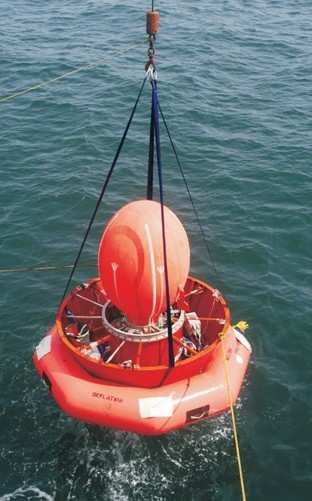Tue, Jan 23, 2007
Major Milestone For Country's Manned Space Program
India's Space Research Organization (ISRO) announced Monday it
has safely deorbited and recovered a capsule launched on January 10
from a facility north of the city of Chennai. The capsule was one
of four payloads aboard the rocket and was part of an effort by the
country to develop a manned spaceflight program.

The 1,210 pound Space Capsule Recovery Experiment (SRE) spent 11
days in orbit before splashing down in the Bay of Bengal yesterday.
(The above picture was taken during capsule recovery testing --
it's not from the actual SRE recovery).
A. Subramoniam, head of the team that designed and built the
capsule at ISRO, told the Sydney Morning Herald, "[It] landed in
the Bay of Bengal ... as per schedule. The mission is a great
success [and] a stepping stone to design and build our very own
reusable spacecraft, and eventually [carry out] manned missions
into space, too."
India's space agency has built and orbited communications
and remote-sensing satellites for years, but this mission marks a
first attempt at deploying a reusable spacecraft.
India's home-grown Polar Satellite Launch Vehicle --
dubbed PSLV-C7 -- carried the capsule aloft along with an
Indian mapping satellite, an Indonesian earth observation satellite
and an Argentinian educational satellite. The four objects were
lifted to a 395-mile polar orbit.

PSLV is ISRO's workhorse launch vehicle. It's a four-stage
rocket using a combination of solid and liquid propellants with a
total lift-off weight of nearly 300 tons. The agency boasts eight
consecutive successful launches with the booster since it
started service in 1994.
The SRE, whose primary mission was to aid India in developing
re-entry procedures and recoverable/reusable space technologies,
also carried two microgravity experiments into space and back to
earth.
Although ISRO officials say the country won't likely put an
astronaut in space before 2014, it says Monday's success will help
the country in its preparations for a 2008 unmanned moon
mission.
More News
Airport Marking Aids Markings used on runway and taxiway surfaces to identify a specific runway, a runway threshold, a centerline, a hold line, etc. A runway should be marked in ac>[...]
"It is extremely difficult, if not impossible, for manned aircraft to see a drone while conducting crop-enhancing and other aerial applications at low altitudes and high speeds. We>[...]
Aero Linx: The Skyhawk Association The Skyhawk Association is a non-profit organization founded by former Skyhawk Pilots which is open to anyone with an affinity for the A-4 Skyhaw>[...]
“The T-54A benefits from an active Beechcraft King Air assembly line in Wichita, Kansas, where all required METS avionics and interior modifications are installed on the line>[...]
Aero Linx: Aerostar Owners Association The Association offers the Aerostar Owner a unique opportunity to tap an invaluable source of information concerning the care and feeding of >[...]
 ANN's Daily Aero-Term (04.28.24): Airport Marking Aids
ANN's Daily Aero-Term (04.28.24): Airport Marking Aids Aero-News: Quote of the Day (04.28.24)
Aero-News: Quote of the Day (04.28.24) ANN's Daily Aero-Linx (04.28.24)
ANN's Daily Aero-Linx (04.28.24) Aero-News: Quote of the Day (04.29.24)
Aero-News: Quote of the Day (04.29.24) ANN's Daily Aero-Linx (04.29.24)
ANN's Daily Aero-Linx (04.29.24)




